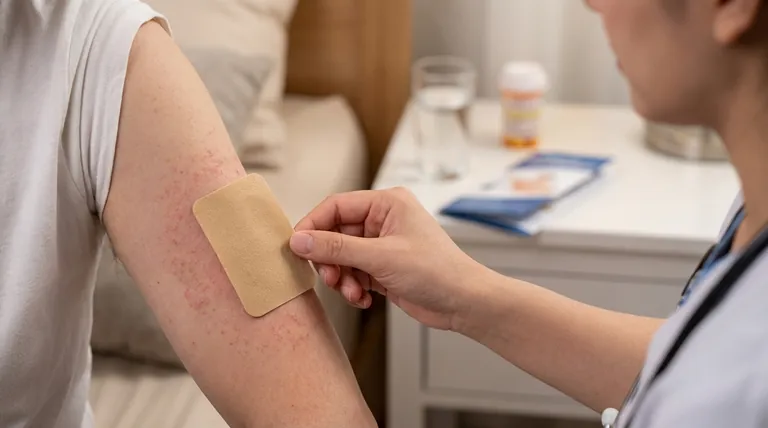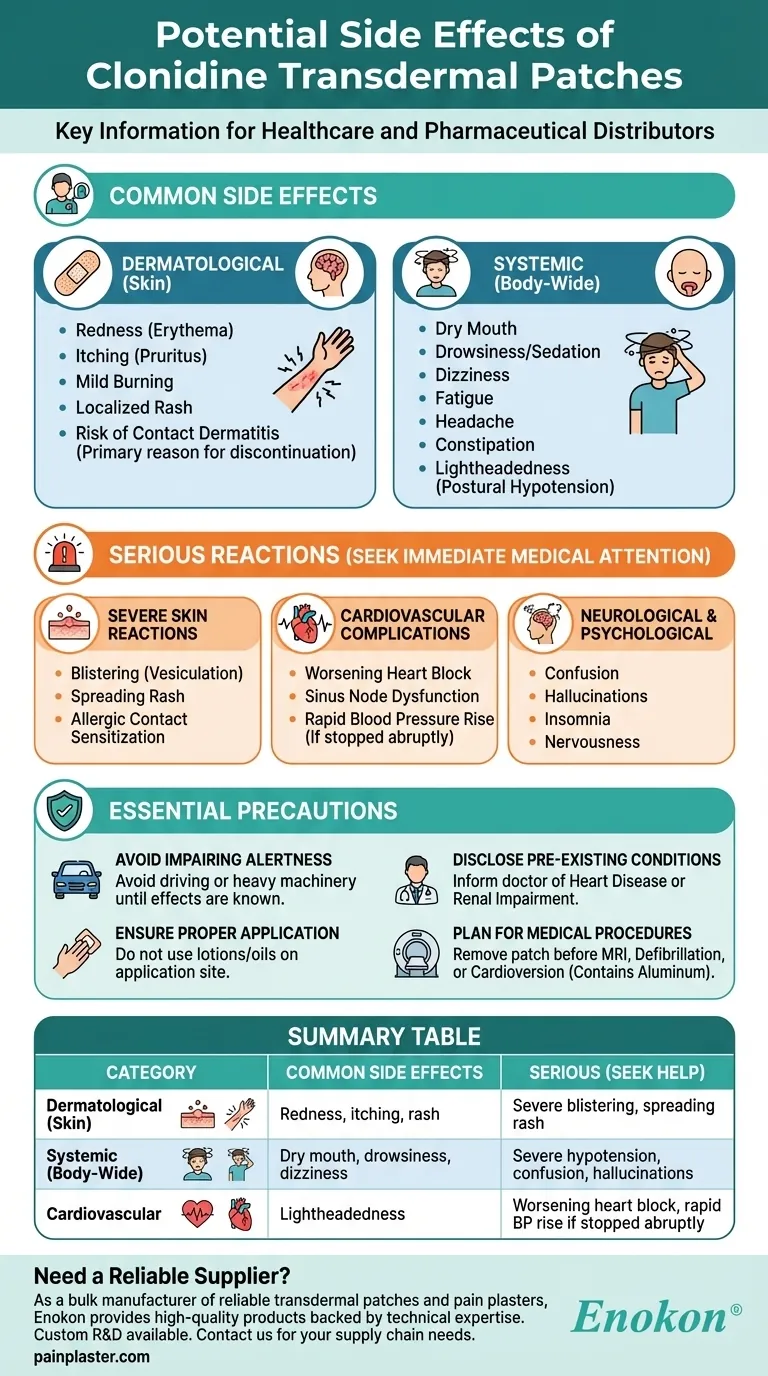The most common side effects of transdermal clonidine are localized skin reactions at the patch site and systemic effects like drowsiness, dizziness, and dry mouth. While most reactions are mild, it is critical to be aware of more serious cardiovascular and neurological effects that require immediate medical attention.
The side effects of the clonidine patch fall into two main categories: predictable reactions on the skin where the patch is applied, and systemic effects throughout the body caused by the medication lowering your blood pressure and acting on your central nervous system.

The Two Categories of Side Effects
Understanding side effects becomes clearer when you separate them based on their origin. Some are a direct result of the patch itself, while others are caused by the medication circulating in your bloodstream.
Dermatological Reactions (At the Application Site)
These are the most frequent adverse reactions reported. The constant contact of the patch with your skin can cause irritation.
Symptoms often include redness (erythema), itching (pruritus), mild burning, or a localized rash. In some cases, more significant reactions like blistering (vesiculation) or skin discoloration can occur.
These skin reactions are a primary reason for discontinuing the patch, with some studies showing that up to 19% of patients stop treatment due to contact dermatitis.
Systemic Effects (Throughout the Body)
Once the clonidine is absorbed into your bloodstream, it affects your entire body, primarily by acting on your central nervous system to lower blood pressure.
The most common systemic effects include dry mouth and drowsiness or sedation.
You may also experience dizziness, fatigue, headache, or constipation. Feeling lightheaded, especially when standing up quickly, is a direct result of lowered blood pressure.
Recognizing Serious but Less Common Reactions
While most side effects are manageable, some are more severe and warrant immediate consultation with your healthcare provider.
Severe Skin Reactions
A mild irritation is common, but a severe, spreading, or blistering rash may indicate a significant allergic contact sensitization. This requires discontinuing the medication.
Cardiovascular Complications
For individuals with pre-existing heart conditions, clonidine must be used with caution. It can worsen issues like sinus node dysfunction or AV block, especially if taken with other similar medications.
In rare cases, a loss of blood pressure control can occur. It is crucial not to stop therapy abruptly, as this can cause a rapid increase in blood pressure.
Neurological and Psychological Effects
Though less frequent, some individuals may experience confusion, hallucinations, insomnia, or nervousness. Seek medical attention for any significant changes in mental state.
Essential Precautions to Minimize Risk
Proper use and awareness of your health status are key to safely using the clonidine patch.
Avoid Impairing Alertness
Clonidine can significantly impair your thinking and reaction times. You should avoid driving or operating heavy machinery until you know how the medication affects you.
Ensure Proper Patch Application
Do not use lotions, oils, or other skin products on the area where you plan to apply the patch. These can interfere with adhesion, leading to insufficient absorption and inadequate treatment.
Disclose Pre-existing Conditions
Inform your doctor if you have any history of heart disease or renal impairment. These conditions require more careful monitoring while using clonidine.
Plan for Medical Procedures
The patch contains aluminum and must be removed before undergoing an MRI, defibrillation, or cardioversion to prevent the risk of skin burns at the patch site.
Making the Right Choice for Your Health
Your primary goal will determine how you and your doctor weigh these potential side effects.
- If your primary focus is managing blood pressure with minimal daily disruption: Be prepared for potential drowsiness and take precautions with activities that require alertness.
- If you have sensitive skin: Practice diligent site rotation for the patch and immediately report any severe irritation, blistering, or spreading rashes.
- If you have a pre-existing heart or kidney condition: Understand that using this medication requires close and continuous medical supervision to monitor for complications.
Ultimately, maintaining open communication with your healthcare provider is the most effective way to manage side effects and ensure your treatment is both safe and effective.
Summary Table:
| Category | Common Side Effects | Serious (Seek Medical Help) |
|---|---|---|
| Dermatological (Skin) | Redness, itching, rash | Severe blistering, spreading rash |
| Systemic (Body-Wide) | Dry mouth, drowsiness, dizziness | Severe hypotension, confusion, hallucinations |
| Cardiovascular | Lightheadedness | Worsening heart block, rapid BP rise if stopped abruptly |
Need a reliable supplier for clonidine transdermal patches or other medication plasters?
As Enokon, a bulk manufacturer of reliable transdermal patches and pain plasters, we provide healthcare and pharmaceutical distributors & brands with high-quality products backed by extensive technical expertise. Benefit from our custom R&D and development services to create effective and safe transdermal solutions for your patients.
Contact our experts today to discuss your specific needs and how we can support your supply chain.
Visual Guide

Related Products
- Far Infrared Heat Pain Relief Patches Transdermal Patches
- Far Infrared Deep Heat Relief Patches Medicated Pain Relief Patches
- Heating Pain Relief Patches for Menstrual Cramps
- Herbal Eye Protection Patch Eye Patch
- Asthma Cough and Pain Relief Patch for Adults and Kids
People Also Ask
- Can heat patches be used for fresh injuries? Avoid This Common Mistake for Faster Recovery
- How do Deep Heat Pain Relief Patches provide pain relief? Discover the Drug-Free Mechanism
- Are heat patches safe for all body parts? Key Safety Zones and No-Go Areas Explained
- How does capsaicin work in the medicated heat patch? The Science Behind Pain Relief
- What types of pain can the Deep Heat Pain Relief Back Patch be used for? Targeted Relief for Muscles & Joints














